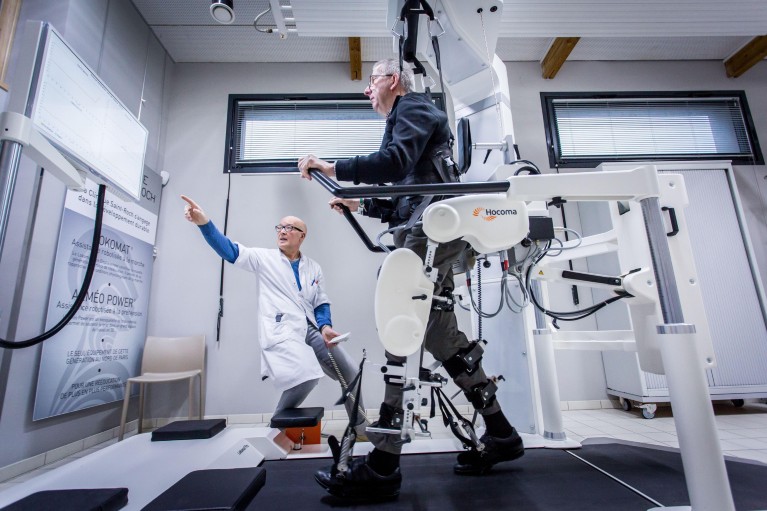
Robotic assistance can be used to support walking during rehabilitation sessions. Phanie/Alamy Stock Photo
Combining robotic technologies with drugs that modulate serotonin could accelerate rehabilitation after a stroke, according to a study published by Italian scientists in Progress in Neurobiology.
Mechatronic devices that precisely assist movements can be used to help patients regain motor functions after central nervous system injury, such as stroke. The devices allow reproducible, controlled repetitive movements, for intensive rehabilitation, but don’t assist with relearning natural untrained movement. Silvestro Micera, Professor of Bioelectronics and Neural Engineering at the Scuola Superiore Sant’Anna in Pisa, who worked on the study, explained that increased brain plasticity (the ability of neurons to replace damaged connections) may help bridge this gap.
The scientists worked with transgenic mice with modified receptors for serotonin, a neurotransmitter that, among other functions can increase neural plasticity. After inducing a stroke, they injected the mice with a substance that targets those receptors and makes them produce serotonin. About 90 minutes after administration, when the hormone release reached its peak, robotic rehabilitation began.
The rehabilitation protocol lasted five weeks, during which mice performing activities and repetitive movements for four days a week, assisted by a mechatronic device. One day per week, the mice were subjected to tests for which they had not received training, such as a ‘reach and grasp’ test during which the researchers recorded the trajectory with which the mouse tried to grab an object. “It is like when a patient rehabilitates by carrying out a precise series of movements and then, when he goes home, he must be able to perform different actions,” explains Sara Conti, first author of the study, who was a doctoral student at the Scuola Superiore Sant’Anna when the research was conducted. The mice treated with a combination of robot training and serotonin stimulation had better results than the control groups, where only one of the two treatments was used1.
The researchers then replicated the results using a drug approved for use in humans, buspirone, this time on wild type mice, achieving comparable effects.
Future research may include recording from selected brain areas of the mice during training to better understand the mechanism that allows improved plasticity during physical exercise, says Micera.
